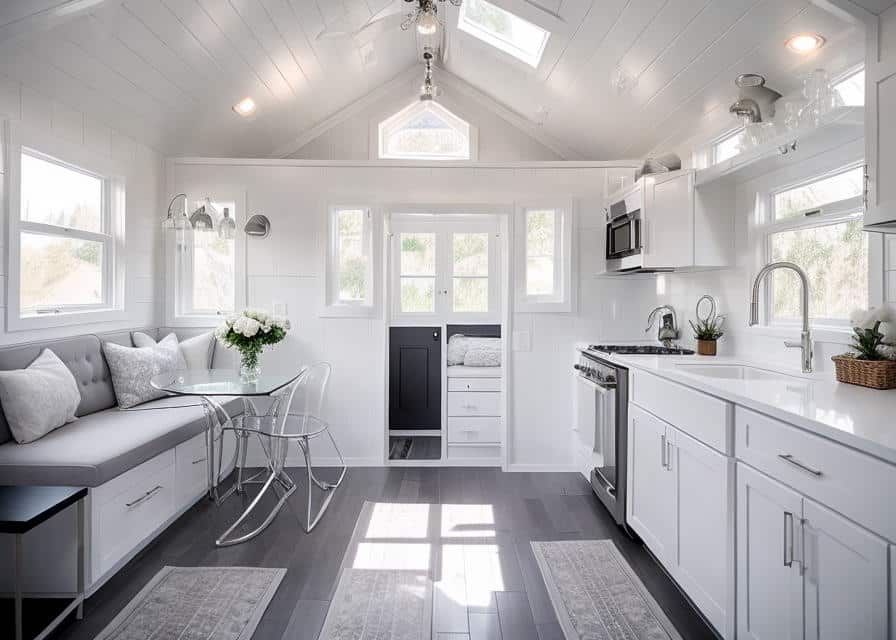Table of Contents
- Introduction
- Building and Designing Your Tiny Home
- Living Off-Grid
- Living in a Tiny Home
- Frequently Asked Questions
- A. What are the benefits of living off-grid in a tiny home?
- B. Is it legal to live off-grid in a tiny home?
- C. How much does it cost to build a tiny home?
- D. What kind of skills do I need to build and maintain a tiny home?
- E. Can I live off-grid in a tiny home with children or pets?
- F. What kind of insurance do I need for a tiny home?
- G. How do I find land to park my tiny home?
- H. How do I stay safe and secure in a tiny home off-grid?
- I. How do I handle waste and sewage in a tiny home?
- J. How do I get access to healthcare and emergency services while off-grid?
Introduction
Living off-grid in a tiny home is an increasingly popular lifestyle choice for those seeking to simplify their lives, minimize their carbon footprint, and reduce their living expenses. It involves living in a self-sufficient home that is not connected to the power grid, water supply, or sewage system, and often involves using alternative sources of energy and water, such as solar panels and rainwater harvesting.
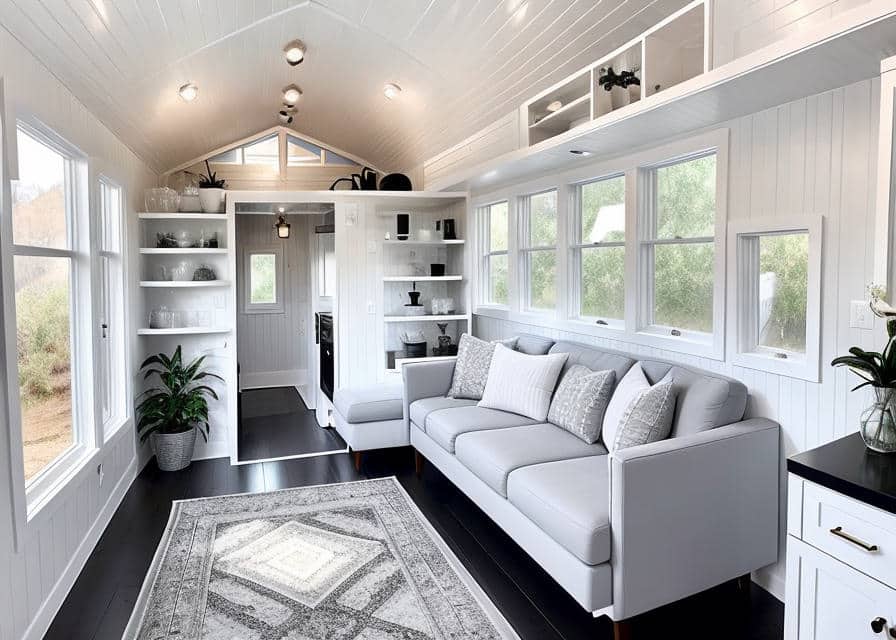
In this comprehensive guide, we will explore the various aspects of living off-grid in a tiny home, including the benefits and challenges of this lifestyle, how to design and build a tiny home, how to live off-grid, and how to adjust to a simpler lifestyle. We will also answer frequently asked questions to help you get started on your off-grid tiny home journey.
Whether you are already committed to living off-grid in a tiny home or are simply curious about this lifestyle, this guide will provide you with valuable information and insights to help you make informed decisions and successfully transition to a simpler and more sustainable way of life.
Building and Designing Your Tiny Home
Building and designing a tiny home is a crucial step in living off-grid. It requires careful planning, creativity, and attention to detail to ensure that your tiny home is safe, comfortable, and functional. Here are some key considerations for building and designing your off-grid tiny home:
A. Choosing a Location: Before you can start building your tiny home, you need to find a suitable location for it. Look for a piece of land that is zoned for residential use and that has access to utilities, such as water and electricity, if you plan on using them. You may also want to consider factors such as the local climate, natural scenery, and proximity to amenities, such as grocery stores and medical facilities.
B. Planning Your Design and Layout: Your tiny home design and layout will depend on your personal preferences, budget, and available space. Some important design considerations include the number and size of rooms, the orientation of the home, the type of roofing and insulation, and the use of eco-friendly materials.
C. Materials and Construction: Building a tiny home requires using high-quality materials and ensuring that the construction is sturdy and durable. Consider using materials such as SIPs (structural insulated panels), which are energy-efficient and provide excellent insulation. You may also want to use reclaimed materials or recycled materials to reduce your environmental impact and save money.
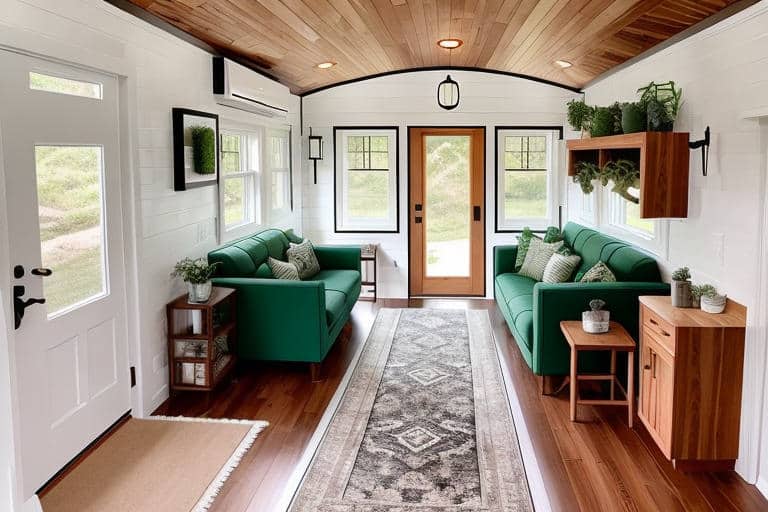
D. Building Codes and Permits: Depending on your location, you may need to obtain building permits and comply with local building codes when constructing your tiny home. Be sure to research these requirements and obtain any necessary permits before beginning construction.
E. Installation of Utilities: One of the most significant challenges of living off-grid is providing your home with power, water, and sewage. Solar panels are a popular choice for providing electricity, while rainwater harvesting and well water can be used for water supply. Composting toilets and greywater systems can be used for waste management.
Building and designing your tiny home is a rewarding process that requires careful planning, creativity, and attention to detail. By considering these key factors, you can ensure that your tiny home is safe, comfortable, and functional, and meets your off-grid living needs.
Living Off-Grid
Living off-grid in a tiny home means that you need to be self-sufficient in terms of energy, water, waste management, and food. Here are some key considerations for living off-grid:
A. Energy Options: One of the most significant challenges of living off-grid is providing your home with power. Solar panels are a popular choice for providing electricity, but you can also use other renewable energy sources such as wind power or hydro power. You may also want to consider a backup generator or battery system for days with little sunshine.
B. Water Options: Water is another critical resource for living off-grid. Rainwater harvesting is a popular option, but you can also use well water or a combination of both. Be sure to have an adequate filtration and purification system to ensure that your water is safe for drinking.
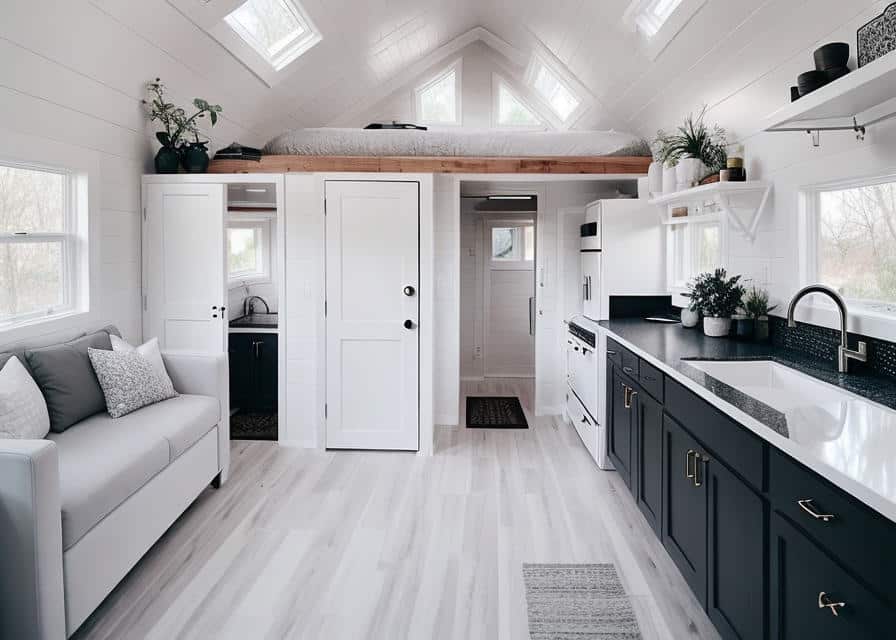
C. Waste Management: Composting toilets and greywater systems can be used for waste management in a tiny home. Composting toilets use natural processes to break down human waste and turn it into compost, while greywater systems filter and reuse water from sinks, showers, and washing machines. Both of these options are eco-friendly and cost-effective.
D. Food Options: Growing your food can be a rewarding and sustainable way to live off-grid. Consider setting up a vegetable garden, fruit trees, and raising small livestock such as chickens. You may also want to consider preserving your food through canning, drying, or fermenting to extend its shelf life.
E. Heating and Cooling Options: Maintaining a comfortable temperature in your tiny home is crucial for your well-being. Consider using a wood stove or a pellet stove for heating and passive solar design for cooling. You may also want to consider insulation and ventilation to regulate the temperature of your home.
Living off-grid in a tiny home requires a bit of adjustment and learning, but with the right planning and preparation, it can be an exciting and fulfilling lifestyle. By considering these key factors, you can ensure that your off-grid living experience is sustainable, comfortable, and enjoyable.
Living in a Tiny Home
Living in a tiny home can be a challenging yet rewarding experience. Here are some key considerations for making the most of your tiny home living experience:
A. Storage and Organization Tips: Maximizing storage space is critical when living in a tiny home. Consider installing built-in storage solutions, such as shelves, cabinets, and drawers. You can also use multi-functional furniture, such as a sofa bed or a storage ottoman, to save space.
B. Maximizing Space and Minimizing Clutter: Living in a tiny home requires a minimalist mindset. Consider downsizing your belongings and keeping only what you need. Use creative space-saving techniques, such as vertical storage or hanging items from the ceiling, to maximize your living space.
C. Decor and Design Ideas: Tiny homes can be stylish and cozy. Consider using light colors to make your space appear larger and using natural materials to create a warm and inviting atmosphere. You can also add personal touches, such as art, photos, or plants, to make your tiny home feel like home.
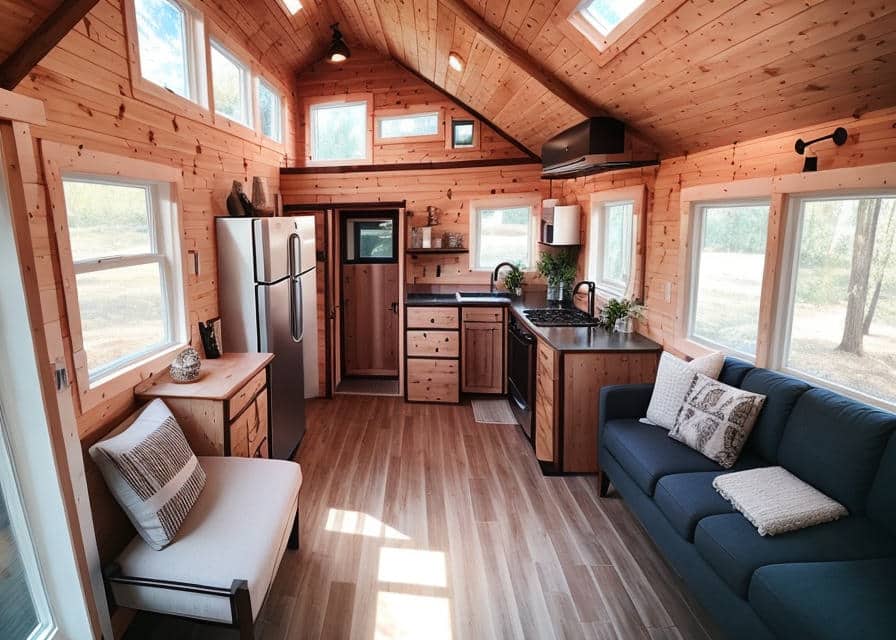
D. Cleaning and Maintenance Tips: Keeping your tiny home clean and well-maintained is critical for your health and well-being. Develop a cleaning schedule and stick to it. Use eco-friendly cleaning products to minimize your environmental impact. And be sure to maintain your home’s systems, such as water filtration and composting toilet, to ensure they function properly.
E. Dealing with Limited Privacy: Living in a tiny home can mean sacrificing privacy. Consider using curtains, room dividers, or privacy screens to create separate living areas. You can also use headphones or earplugs to minimize noise from others in the home.
Living in a tiny home requires adjusting to a new way of life, but with the right mindset and preparation, it can be a rewarding and fulfilling experience. By considering these key factors, you can maximize your living space, keep your home clean and well-maintained, and create a cozy and inviting atmosphere.
Frequently Asked Questions
Here are some frequently asked questions about living off-grid in a tiny home:
A. What are the benefits of living off-grid in a tiny home?
Living off-grid in a tiny home can have many benefits, including reducing your living expenses, minimizing your environmental impact, and simplifying your life. By being self-sufficient and using alternative sources of energy and water, you can reduce your reliance on traditional utilities and lower your carbon footprint. You can also save money by living in a smaller, more efficient home that requires less maintenance and upkeep.
B. Is it legal to live off-grid in a tiny home?
The legality of living off-grid in a tiny home varies depending on your location. Some areas have zoning laws that restrict the use of tiny homes as permanent dwellings, while others have no restrictions. Before building or living in a tiny home, be sure to research your local building codes and zoning laws to ensure that you are complying with all relevant regulations.
C. How much does it cost to build a tiny home?
The cost of building a tiny home can vary widely depending on the size, materials, and level of customization. A basic, self-built tiny home can cost as little as $10,000, while a more high-end custom-built home can cost upwards of $100,000. Be sure to factor in the cost of permits, materials, and labor when budgeting for your tiny home.
D. What kind of skills do I need to build and maintain a tiny home?
Building and maintaining a tiny home requires a range of skills, including basic carpentry, plumbing, and electrical skills. You may also need to have skills in renewable energy and water management. If you don’t have these skills, you can learn them through books, online tutorials, or by taking classes at your local community college or adult education center.
E. Can I live off-grid in a tiny home with children or pets?
Living off-grid in a tiny home with children or pets is possible, but it requires careful planning and consideration. You will need to ensure that your tiny home has enough space to accommodate everyone, and that it meets your family’s needs for food, water, and waste management. Be sure to research child and pet-friendly designs and consider their needs when designing and building your tiny home.
F. What kind of insurance do I need for a tiny home?
Insurance for tiny homes can vary depending on your location and the type of tiny home you have. You may need to have liability insurance if you plan on using your tiny home for business purposes, such as renting it out as a vacation rental. You may also want to consider insurance for your personal belongings and the structure of your home.
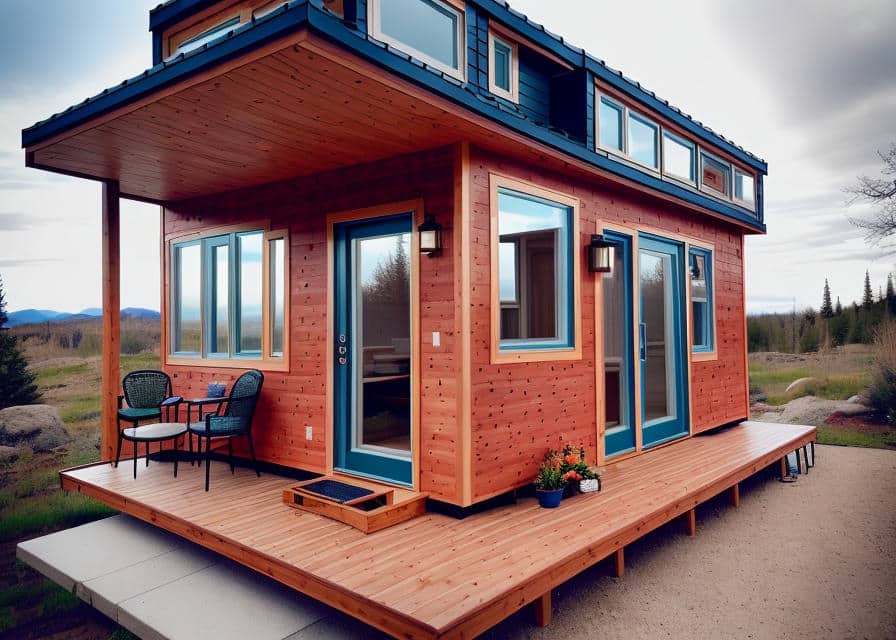
G. How do I find land to park my tiny home?
Finding land to park your tiny home can be challenging, but there are options available. You can look for privately owned land, such as a friend or family member’s property, or rent a space in a tiny home community or RV park. Be sure to research local zoning laws and regulations before parking your tiny home on any land.
H. How do I stay safe and secure in a tiny home off-grid?
Living off-grid in a tiny home can be safe and secure with the right precautions. Be sure to have a security system in place, such as motion sensors or cameras, to deter burglars. You may also want to consider a dog or a sturdy lock on your doors and windows. Have an emergency plan in place, such as an evacuation plan or a communication plan in case of a natural disaster.
I. How do I handle waste and sewage in a tiny home?
Waste and sewage management in a tiny home can be challenging but there are options available. Composting toilets are a popular option for waste management, using natural processes to break down human waste into compost. Greywater systems can also be used to filter and reuse water from sinks, showers, and washing machines. Be sure to follow the instructions for using these systems carefully to avoid any issues with odors or health hazards.
J. How do I get access to healthcare and emergency services while off-grid?
Living off-grid in a remote location can make access to healthcare and emergency services challenging. Consider researching local healthcare providers and hospitals, and have a plan in place for emergencies, such as knowing the location of the nearest hospital or having a satellite phone or other communication device. Be sure to have a well-stocked first aid kit and know how to administer basic medical care in case of an emergency.
Living off-grid in a tiny home can be a unique and fulfilling experience. By considering these frequently asked questions and planning carefully, you can create a sustainable, comfortable, and enjoyable off-grid lifestyle.

